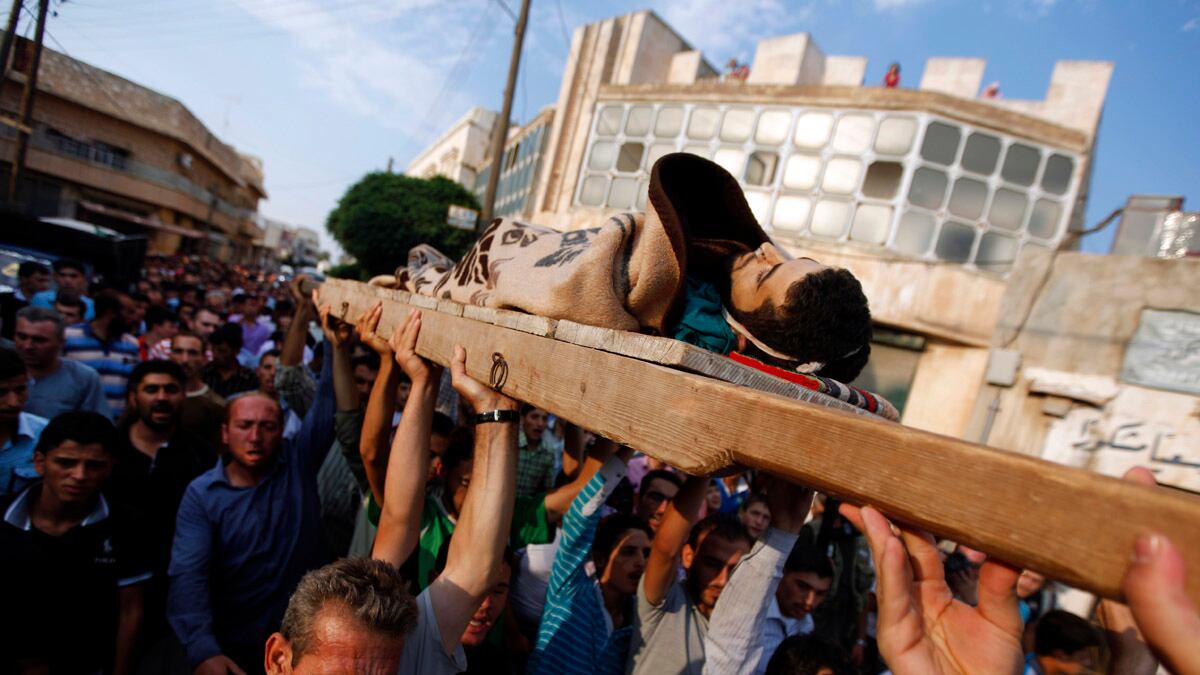Tank shells dropped about one a minute yesterday on the narrow streets of the battered Salaheddin district of Aleppo as exhausted rebel commanders finally conceded they no longer could contain a Syrian government offensive that’s built in intensity and firepower the past week, leaving hundreds dead and wounded, many of them civilians.

With shelling and sniper fire pursuing them, hundreds of insurgents lugged RPG7 rocket launchers, heavy machine guns, and their all-purpose AK47s out of the district and filtered into neighborhoods adjacent to Salaheddin to set up new defensive positions in buildings mainly to the north and east, and to await the next move of their better-equipped adversaries.
Only days ago, as warplanes and helicopter gunships struck at rebel forces, Free Syrian Army commanders insisted they would retain the district in the southwest of Syria’s second-largest city, arguing that its strategic importance made it essential for them to hold it. Salaheddin lies on a vital supply and logistics route for government forces wanting to move men and materiel north to retake a string of towns running south from the Turkish border at Kilis.
With Syrian state media gloating over yesterday’s pullback, claiming that the army can now set about reclaiming more of Aleppo, the country’s commercial center, rebel commanders were intent on putting the bravest face they could on the withdrawal, although the pullback clearly unnerved their men.
“I am scared,” said one fighter. “If we can’t hold Salaheddin, can we hold Aleppo or the towns we have liberated to the north?’ queried Omar al-Rahman, a 21-year-old fighter.
Sitting in a coffee house now serving as his makeshift headquarters just yards from Salaheddin, the commander of the Abu Bakr brigade, 32-year-old Zaher Sherkat, declined to concede that the rebels were retreating. He emphasized the tactical nature of the pullback, saying the rebels intended to form a new line in the Saif al-Dawla and Mashhad districts.
“There was very heavy shelling this morning and more government snipers sneaked in, and so we have just rearranged our forces more sensibly,” he told The Daily Beast. Two of his soldiers were killed just hours earlier by snipers he suspects may have been Iranians. “We have heard the snipers talk and they don’t speak Arabic, but Persian,” he said.
On Saturday, rebels in Damascus seized 48 Shiite pilgrims from Iran, claiming they were military personnel sent to aid the Assad regime, an assertion Iran has denied vehemently. On Tuesday, Iranian Foreign Minister Ali Akbar Salehi asked Turkey to intercede with the Syrian rebels to secure the release of the Iranians. Iranian government spokesmen have acknowledged that several of the Shiite pilgrims served in the Revolutionary Guards, but insisted they had retired long ago.
Iranians or not, the Abu Bakr commander says the snipers weren’t the biggest challenge rebels faced in Salaheddin. Missile strikes from warplanes and helicopter gunships and tank shelling made the pullback necessary, he says. But he insists it is not a full withdrawal. “We now are around Salaheddin,” he said, arguing that he and his fellow commanders intend to harass government forces.
As he spoke, the tea glasses on the table shook as a barrage of tank shells hit with loud thuds nearby, sending sizzling hot chunks of shrapnel skidding across the street outside and raining down on the roof of the coffee house. Outside, his young fighters—the average age of his brigade is just 20—ducked into buildings for cover, and the few civilians around scurried off or beseeched rebels to tell them what place was safe to go to avoid the shelling or the snipers.
The battle for Salaheddin has involved some of the fiercest fighting of the 17-month-long insurgency aimed at toppling Syrian President Bashar al-Assad. Most of the district’s residents have fled, leaving many of the streets to the snipers and embattled rebels. Scores of houses have been flattened—40 alone yesterday, according to one FSA commander—and few have remained undamaged. Bodies are buried in the rubble, and the dead have lain for days on the debris-strewn streets where snipers shot them.
Since rebels seized key districts in Aleppo three weeks ago, the Assad government has slowly amassed forces, moving mechanized units and paramilitaries from the feared Shabiha militia into the southwest of the city. A senior regime official warned several days ago: “What you are seeing is the appetizer: the main course is yet to come.”
There were signs Wednesday morning that the assault would be too much for the 350 or so rebel fighters battling to maintain their hold of the district when tanks began to penetrate Salaheddin. With the tanks being able to bombard more selectively, hitting at pockets of resistance, snipers picked off rebels and civilians alike.
According to a doctor who declined to be named, The Healing Center in the district of Shaar, one of the main treatment centers for the rebels, has been handling more than a hundred casualties a day from Salaheddin and adjacent neighborhoods, mostly civilians.
The rebels still control several other districts, including some in the east and north of the city, but they too are now beginning to come under bombardment from the air. In the past week, government fighter jets also have started to attack towns north of Aleppo, including Hreitan, Al Bab and Tel Rifat, where on Wednesday they hit a house and a high school, killing six people from one family, say rebel commanders.
These attacks suggest the government may intend to try to exploit rapidly its seizing of Salaheddin and to start moving north quickly, endangering the rebels’ supply routes from Turkey, and curtailing their control of considerable territory north of Aleppo. Such losses would be a severe blow for the rebellion. A key question is whether the Syrian army has the ability to move fast. That it has taken so long to capture Salaheddin from a small rebel force raises doubts about its tactical skill and morale.






